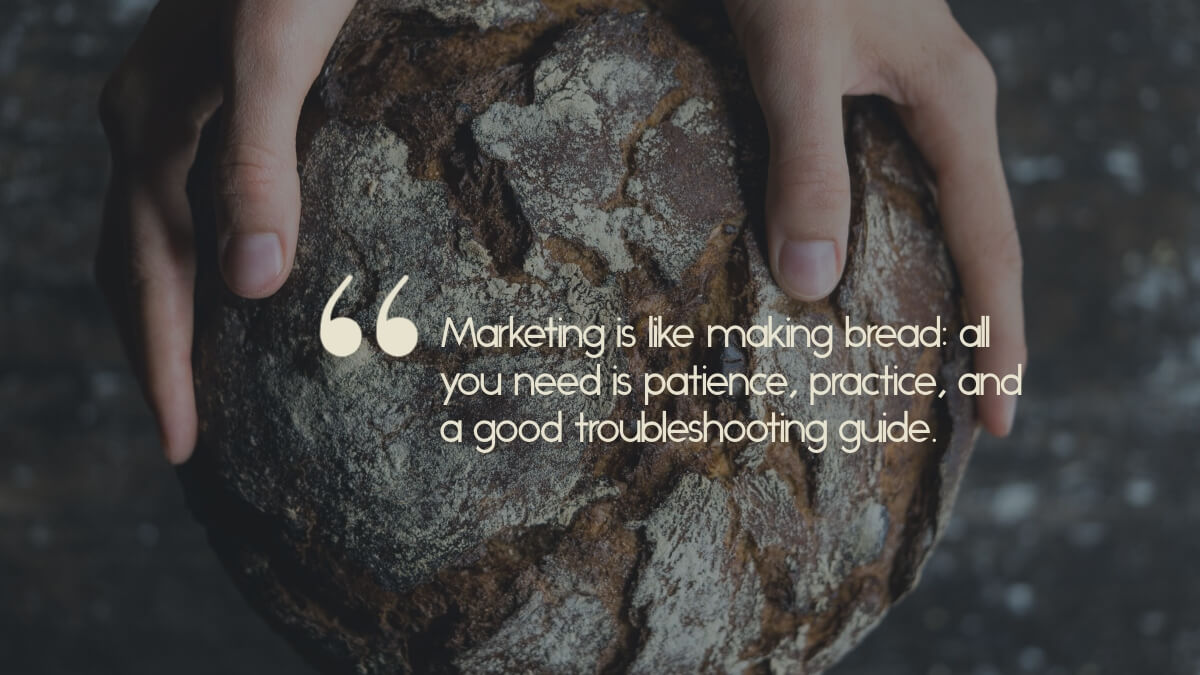Six quick Marketing troubleshooting tips (or why marketing is like baking bread)

Marketing a small business is a bit like making bread. You add all the right ingredients, do the right steps, and if you know what you’re doing, you end up with great results. But go a little bit wrong along the process – knead it too much, let it rise too long, mess up the ingredients – and you’ll find yourself without much to sink your teeth into.
Before you run off sobbing to your desk, let me give you that glimmer of hope, though: sure, good marketing can take a bit of experience, but just like making bread, ANYONE ACTUALLY CAN DO IT. You just need to practice a bit.
Play with the ingredients. Tweak your technique. Stick with it. Soon enough you’ll be making lots of bread.
(Yes, that last pun was intended. I refuse to apologize)
With that in mind, we thought we’d put together a few ways people get off-track in their marketing efforts. We hope it can help you tweak your technique for better results.
Ask yourself:
-
Have you made it very, very clear what your product is and why people would want it? Remember, even though the “why” of a product or service is super obvious to us, it’s not always obvious to someone who isn’t familiar with our business. I can’t tell you how many websites I’ve visited – this is especially pernicious with SAS companies – and couldn’t for the life of me figure out what the heck they were selling. Pro tip: consult a complete stranger and have them review your website, marketing copy, or ad to make sure they’re clear on what you’re selling and why they might want it. Second pro tip: the “why” can be shown with good product imagery or graphics, of course, not just text.
-
Have you made it super easy for people to buy your product or contact you? A lot of business owners want to include all the information that they possibly can, in the mistaken opinion that it will help sell the product. In reality, that just tends to add unnecessary complexity to websites and ads. Instead, make your ads simple and focus on the most important points. Keep your websites clean and spare. And limit the number of clicks between a customer’s arrival to your site and a sale or lead form. The last thing people want to do is wade through tons of miscellaneous information or web pages to figure out how to buy your thing.
-
Are you showing them too much selection? Yes, you can show too much sometimes. This applies both to ads (please don’t list all your services or show lots of products in a single ad) and also to e-commerce sites. Despite examples set by behemoths like Amazon, offering every last thing you ever sold on your website just makes it harder for customers to find the thing they actually want (remember, Amazon has powerful purchase history and search algorithms that help you find stuff you’re likely to want – your eCommerce platform probably isn’t that sophisticated). Instead, look at your sales data and focus your attention on the items that you know sell well. Just like Goldilocks, you need to find the balance between having too few options and too many.
-
Are you targeting the audience that is most likely to buy your product or service? Remember, marketing is a simple formula: get the right message in front of the right audience, as often as possible. If you have sales or customer data, use that to define your audience (check out our blog on the subject here). Then make sure you’re using that information to choose your marketing channels (where your ads will appear) and your targeting criteria for digital advertising. And be aware that targeting may change from product to product. For instance, if you’re a masseuse but you’re offering a massage training course, your targeting is likely very different for those ads than they would for your normal massage services.
-
Are your ads eye-catching? Sound obvious, right? But also often overlooked. It’s pretty easy to put together an ad that says what you want it to say, but completely forget to make sure that people will see it when they’re leafing through the paper or clicking through a website. Keep your text to a minimum and use great imagery (bonus points if it has faces… people like faces). For more on building great ads, see here.
-
Are people seeing your ads enough? This is a particular challenge for smaller ad budgets since smaller budgets often lead to less frequency (a marketing term that means how many times each person will see the ad over a period of time). And less frequency means poorer results. It’s not just that your ad is showing up less – with lower frequency, ads actually don’t perform as well. You often see click-through rates go up as frequency goes up. Pro tip: if you have a small budget, limit your audience size, either by demographic or geographic targeting. Sure, you can sell your product across the U.S., but you might want to limit yourself to the areas most likely to buy your product so that more people can see your ads more times.
Sure, there are other things we could troubleshoot, but those are the biggies, and probably enough for now. Really, just take the time to practice and play with your results. And remember, just like you know good bread is possible (you’ve seen it and eaten it), know that good marketing is equally possible. Sure, it sometimes takes time to find the right recipe, but, yes, folks, you do it!
Happy small business marketing,
Katie & Theron

